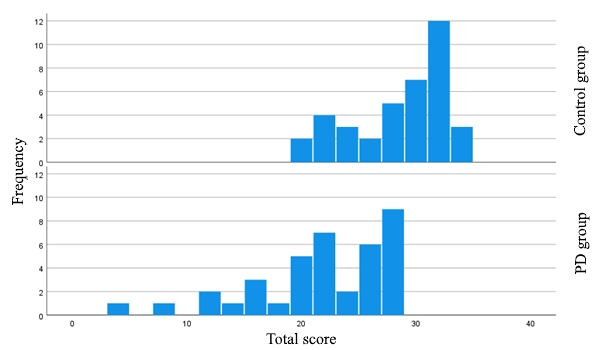Category: Allied Healthcare Professionals
Objective: The study aimed to evaluate balance using a proposed set of tests in people with Parkinson’s disease compared to healthy people.
Background: Numerous balance assessment tools have been developed and used to evaluate balance in Parkinson’s disease (PD) [1]. The Balance Evaluation Systems Test (BESTest) is characterized by good reliability and validity [2,3], however is time-consuming [3]. A shorter version of BESTest has been proposed, based on Brief-BESTest with additional tests that are sensitive to typical balance problems in PD (eg. retropulsion and dual-task performance).
Method: 37 pairs consisting of 1 person with idiopathic PD and 1 healthy match person (by age, sex and level of activity) were examined [table1]. All participants were examined using a set of selected tests consisting of 11 items from six sections of BESTest plus 2 other trials. The set included: biomechanical constraints (1) reaching forward (2), a one-leg stance on both sides (3); compensatory stepping in 4 directions (4); standing on foam with eyes closed (5), Timed Up&Go (TUG) without and with dual-tasks (cognitive – DUAL C and motor – DUAL M), and as fast as a possible version (TUG FAST). A comparative analysis of the results between groups was carried out, without and with an additional division into age groups.
Results: There were statistically significant differences in the total results of functional tests between the group of people with Parkinson’s disease and the control group (median 66.67% PD vs. 91.67% controls), shown in [figure1]. The results of the majority of tests differed statistically significantly between the groups, which is presented in [table2]. The analysis of the dependence on age showed that the total test result may depend on the age of the participants [table3]. However, regardless of age, the differences are statistically significant between people with PD and the controls. Tests that distinguished people with PD from controls, regardless of age, were found [table4].
Conclusion: The occurrence of balance disorders in Parkinson’s disease is possible at an early stage of the disease. The proposed set of tests allows the detection of balance problems in people with PD at a young age. In addition, the set is easy to administer, cheap, and not time-consuming. However, future studies should involve a bigger sample and evaluate the clinimetric properties of the presented set of tests.
References: [1] Krzysztoń, K., Stolarski, J., & Kochanowski, J. (2018). Evaluation of Balance Disorders in Parkinson’s Disease Using Simple Diagnostic Tests-Not So Simple to Choose. Frontiers in neurology, 9, 932. https://doi.org/10.3389/fneur.2018.00932
[2] Horak, F. B., Wrisley, D. M., & Frank, J. (2009). The Balance Evaluation Systems Test (BESTest) to differentiate balance deficits. Physical therapy, 89(5), 484–498. https://doi.org/10.2522/ptj.20080071
[3] Duncan, R. P., Leddy, A. L., Cavanaugh, J. T., Dibble, L. E., Ellis, T. D., Ford, M. P., Foreman, K. B., & Earhart, G. M. (2013). Comparative utility of the BESTest, mini-BESTest, and brief-BESTest for predicting falls in individuals with Parkinson disease: a cohort study. Physical therapy, 93(4), 542–550. https://doi.org/10.2522/ptj.20120302
To cite this abstract in AMA style:
K. Krzysztoń, J. Stolarski, A. Poznańska, J. Kochanowski. Balance evaluation in Parkinson’s disease using a set of simple tests [abstract]. Mov Disord. 2022; 37 (suppl 2). https://www.mdsabstracts.org/abstract/balance-evaluation-in-parkinsons-disease-using-a-set-of-simple-tests/. Accessed April 26, 2025.« Back to 2022 International Congress
MDS Abstracts - https://www.mdsabstracts.org/abstract/balance-evaluation-in-parkinsons-disease-using-a-set-of-simple-tests/

